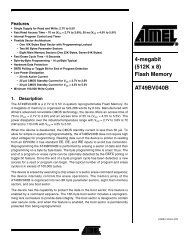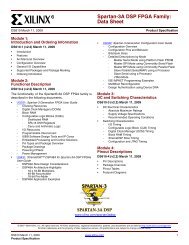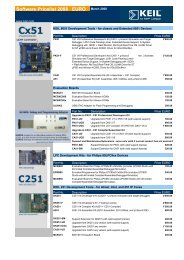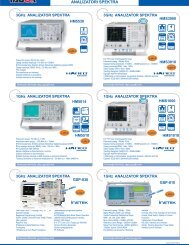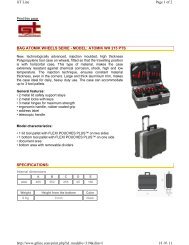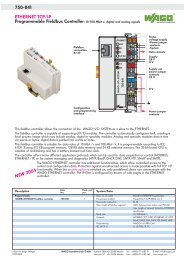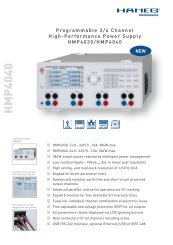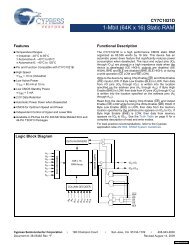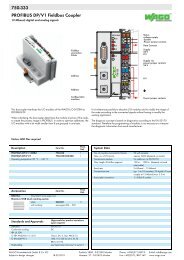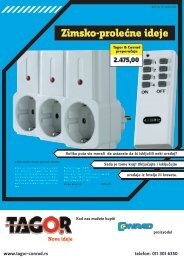PIC12F683 Data Sheet - Microchip
PIC12F683 Data Sheet - Microchip
PIC12F683 Data Sheet - Microchip
Create successful ePaper yourself
Turn your PDF publications into a flip-book with our unique Google optimized e-Paper software.
<strong>PIC12F683</strong><br />
12.4 Interrupts<br />
The <strong>PIC12F683</strong> has multiple interrupt sources:<br />
• External Interrupt GP2/INT<br />
• Timer0 Overflow Interrupt<br />
• GPIO Change Interrupts<br />
• Comparator Interrupt<br />
• A/D Interrupt<br />
• Timer1 Overflow Interrupt<br />
• Timer2 Match Interrupt<br />
• EEPROM <strong>Data</strong> Write Interrupt<br />
• Fail-Safe Clock Monitor Interrupt<br />
• CCP Interrupt<br />
The Interrupt Control register (INTCON) and Peripheral<br />
Interrupt Request Register 1 (PIR1) record individual<br />
interrupt requests in flag bits. The INTCON register<br />
also has individual and global interrupt enable bits.<br />
The Global Interrupt Enable bit, GIE of the INTCON<br />
register, enables (if set) all unmasked interrupts, or<br />
disables (if cleared) all interrupts. Individual interrupts<br />
can be disabled through their corresponding enable<br />
bits in the INTCON register and PIE1 register. GIE is<br />
cleared on Reset.<br />
When an interrupt is serviced, the following actions<br />
occur automatically:<br />
• The GIE is cleared to disable any further interrupt.<br />
• The return address is pushed onto the stack.<br />
• The PC is loaded with 0004h.<br />
The Return from Interrupt instruction, RETFIE, exits<br />
the interrupt routine, as well as sets the GIE bit, which<br />
re-enables unmasked interrupts.<br />
The following interrupt flags are contained in the<br />
INTCON register:<br />
• INT Pin Interrupt<br />
• GPIO Change Interrupt<br />
• Timer0 Overflow Interrupt<br />
The peripheral interrupt flags are contained in the PIR1<br />
register. The corresponding interrupt enable bit is<br />
contained in the PIE1 register.<br />
The following interrupt flags are contained in the PIR1<br />
register:<br />
• EEPROM <strong>Data</strong> Write Interrupt<br />
• A/D Interrupt<br />
• Comparator Interrupt<br />
• Timer1 Overflow Interrupt<br />
• Timer2 Match Interrupt<br />
• Fail-Safe Clock Monitor Interrupt<br />
• CCP Interrupt<br />
For external interrupt events, such as the INT pin or<br />
GPIO change interrupt, the interrupt latency will be<br />
three or four instruction cycles. The exact latency<br />
depends upon when the interrupt event occurs (see<br />
Figure 12-8). The latency is the same for one or<br />
two-cycle instructions. Once in the Interrupt Service<br />
Routine, the source(s) of the interrupt can be<br />
determined by polling the interrupt flag bits. The<br />
interrupt flag bit(s) must be cleared in software before<br />
re-enabling interrupts to avoid multiple interrupt<br />
requests.<br />
Note 1: Individual interrupt flag bits are set,<br />
regardless of the status of their<br />
corresponding mask bit or the GIE bit.<br />
2: When an instruction that clears the GIE<br />
bit is executed, any interrupts that were<br />
pending for execution in the next cycle<br />
are ignored. The interrupts, which were<br />
ignored, are still pending to be serviced<br />
when the GIE bit is set again.<br />
For additional information on Timer1, Timer2,<br />
comparators, ADC, data EEPROM or Enhanced CCP<br />
modules, refer to the respective peripheral section.<br />
12.4.1 GP2/INT INTERRUPT<br />
The external interrupt on the GP2/INT pin is<br />
edge-triggered; either on the rising edge if the INTEDG<br />
bit of the OPTION register is set, or the falling edge, if<br />
the INTEDG bit is clear. When a valid edge appears on<br />
the GP2/INT pin, the INTF bit of the INTCON register is<br />
set. This interrupt can be disabled by clearing the INTE<br />
control bit of the INTCON register. The INTF bit must<br />
be cleared by software in the Interrupt Service Routine<br />
before re-enabling this interrupt. The GP2/INT interrupt<br />
can wake-up the processor from Sleep, if the INTE bit<br />
was set prior to going into Sleep. See Section 12.7<br />
“Power-Down Mode (Sleep)” for details on Sleep and<br />
Figure 12-10 for timing of wake-up from Sleep through<br />
GP2/INT interrupt.<br />
Note:<br />
The ANSEL and CMCON0 registers must<br />
be initialized to configure an analog<br />
channel as a digital input. Pins configured<br />
as analog inputs will read ‘0’ and cannot<br />
generate an interrupt.<br />
DS41211D-page 92<br />
© 2007 <strong>Microchip</strong> Technology Inc.



